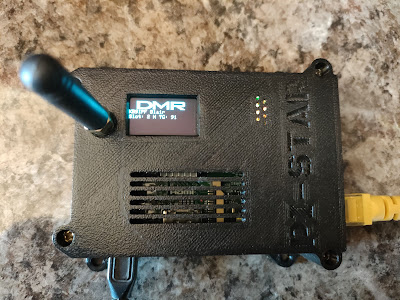There is quite a few hardware hot-spot versions available in the market today. A few years ago I purchased a "cheap" Simplex Jumbospot directly from overseas. I included the OLED screen and metal case. On arrival I installed the firmware and took some time to tune the unit for a low BER with my TYT MD380 Radio. The unit worked flawlessly until recently when I started to get errors when the unit is switch on every morning. (The best would be to leave the hot-spot on all the time.) I expected that a software glitch was causing the hot-spot to "CLOSE" unexpectedly. I also experienced connectivity issues to Brandmeister. Once the unit started up without errors it would run fine without issues but I was fed-up to fiddle with the unit every time I started it. I re-installed the MMDVM firmware but this did not solve the issues on hand. I replaced the older Raspberry Pi Zero with a newer version but the issues remain. On close inspection of the metal cabinet I noticed the the spacing between the Zero and the metal case was very close and that the soldering ends might contact the case. Isolated this did not solve the issues. However I noticed that when I leave the metal cabinet open the unit would startup without errors. Closing the cabinet the intermittent issues would return. Not on a regular basis but just when it really wants to annoy you or when you do not have time to fiddle around to get the hotspot started. I checked for dry solder joints but did not find any. Was it time for a new more expensive hot-spot?
I remembered that when I purchased the Jumbospot I did not have a Pi Zero on hand and that I used a Raspberry Pi 3b to run the unit. Man this thing was flying with the 3b. It was fast and worked far better than the Zero. I pulled out a RP 3b, installed the Jumbospot on the GPIO pins and switched on. What a difference! The unit was fast, responsive and worked flawlessly without any errors. I ran it for a few days shutting it down, restarting, rebooting it after a few hours every day. The errors did not re-appear. The only issue I had on hand was that I did not have a case for the unit. It was now larger than before and I had to find a case. A Raspberry Pi 3b case will not work either as it was to small and could not house the Jumbospot.
Back to the drawing board. The only way out would be to 3D print a case for the unit. After some searching on Thingiverse I found the STL files to 3D print a very useful case. It took 7 hours to print the case but the end result was worth the time spend. After completion of the print I fitted the hot-spot into the case fired it up and once again tested to see if the previous errors would return. It ran beautifully as it should without any issues. I guess the unit was asking for an upgrade. This upgrade was really a great improvement to my MMDVM ventures and I now have a fast, reliable Simplex Jumbospot in the Shack to use.
Finally: I would like to thank "Coffeebuilt" for creating such a modern looking and practical case for the MMDVM Pi-Star Hot-Spot. I would recommend others to use his designs in this regard. The link to his Thingiverse page is available HERE.
Images (Click on images for larger view)















